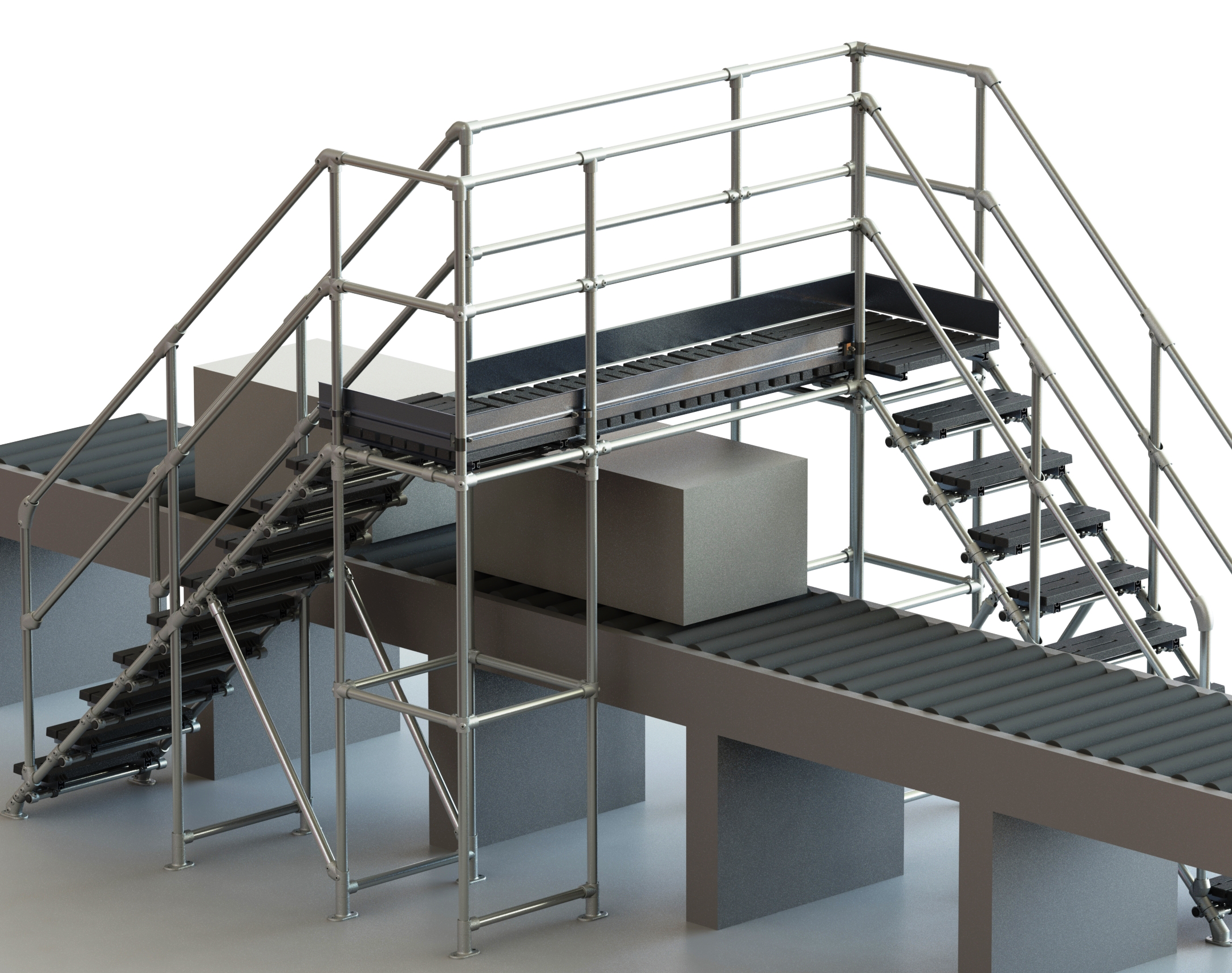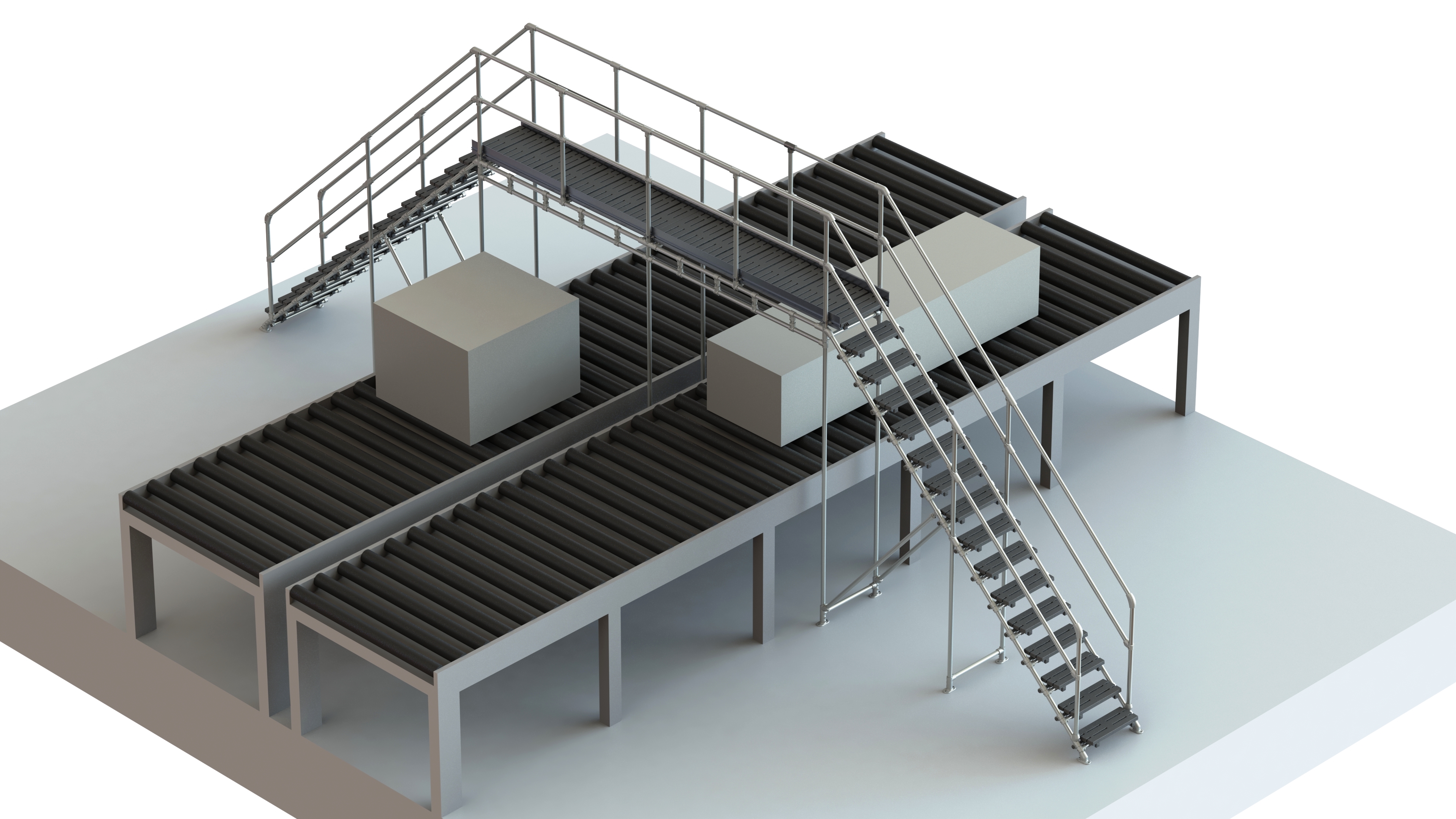Crossing Over Conveyors Safely

Traveling throughout an industrial area, such as a distribution, warehouse, or manufacturing center, can be risky. Over the years, material handling technology has improved to increase efficiency and put less ergonomic strain on the employees with conveyor systems.
Conveyor belts are large pieces of equipment that introduce safety risks, including nip points, and they create a physical barrier in the workplace that employees will need to navigate. A workplace that uses a conveyor system should provide training for employees to ensure that they are aware of the potential hazards, and the controls in place to minimize injuries.
Thankfully, there are conveyor crossover systems that provide a designated walkway through, over or under hazardous conveyor belts that allow workers to travel from one side to the other safely.
Benefits of Conveyor Crossover Systems
Conveyor crossovers are a great tool to minimize risk and will provide many different benefits to your workplace.
Minimize Unsafe Acts
Providing your employees with safe options to cross over a conveyor belt will reduce the likelihood of user error and unsafe acts of climbing over or under a conveyor belt. Everyday safety is a choice; convenient crossings will enable your employees to make the safe choice.
Reduce Injuries
Conveyors frequently have nip points that can catch an item of clothing, hair, or a lanyard and cause severe harm to the employee. While machine guarding is the law, a good practice would be to separate employees from these hazards as much as possible, regardless of if they are guarded.
Increase Productivity
Crossovers improve travel efficiency by not requiring someone to walk around long sections of conveyors and they don’t require the conveyor to stop for someone moving across the facility. These improvements may be incremental, but they scale up to make a sizable impact on the overall efficiency and productivity of the worker.
Improve Emergency Evacuations
During an emergency, people will follow the most direct and intuitive route to safety. Shorter evacuation routes in an emergency mean more people can escape before injury or death can occur.
OSHA Regulations for Conveyor Safety
If workers need to cross over a conveyor, OSHA has specific requirements for both Construction and Marine applications of Conveyor Crossovers. In addition, General Industry applications must adhere to OSHA regulations for Ladder Safety 1910.23 (if applicable) and Walking-Working Surfaces 1910.28.
For construction, the following regulations are applicable:
- 1926.555(a)(5)“Where a conveyor passes over work areas, aisles, or thoroughfares, suitable guards shall be provided to protect employees required to work below the conveyors.”
- 1926.555(a)(6) “All crossovers, aisles, and passageways shall be conspicuously marked by suitable signs.”
- Maritime regulations are similar, reading:
- 1917.48(a)(2)“An elevated walkway with guardrail or equivalent means of protection shall be provided where employees cross over moving conveyors, and suitable guarding shall be provided when employees pass under moving conveyors.”
Crossing Over a Conveyor Safely
Fortunately, there are many options available that will allow you to choose the best crossing solution for your facility. Many workplaces use a variety of the below options, and an expert can help you identify opportunities for improvement and help you build a customized system if off-the-shelf products don’t suit your needs.
Conveyor Overpass
Conveyor overpasses are where a conveyor section is raised to allow for travel beneath it. This option requires the conveyor to be angled up, over, and back down for a section. The benefits of an overpass include the uninterrupted flow of traffic and allows for small vehicles and pushcarts to go through the gap depending on the size of the overpass.
This option does require an adequate vertical clearance and horizontal length to allow the conveyor to reach the required height. Since there will be workers and equipment moving under the overpass, there is the potential for material to fall on them. Additionally, once this application is implemented, changing to allow different size equipment to be moved below is difficult.
Crossover Platforms

Crossover platforms allow personnel to travel over the conveyor, typically by ladders or stairs. Crossover platforms can be constructed out of steel with your choice of footing for wet or dry environments.
This option allows for an uninterrupted traffic flow and design flexibility to accommodate space restrictions.
In addition, many platforms are modular, so if business needs change, they can be relocated to better suit the company’s needs. This option also protects workers as they will travel above the conveyor with guardrails to protect them from falling, and workers are not at risk of items falling on them.
A potential drawback to this option is that it does not allow for vehicle traffic, so powered industrial trucks, or forklifts, will need an alternate route. Vertical and horizontal space should also be considered to enable material to pass safely underneath the platform. You will also need adequate space on both sides of the conveyor to ensure the employees have room to mount and dismount the platform safely.
Conveyor Belt Gates
Conveyor belt gates are used to create a walkway through a conveyor system. Usually, this is done by creating a hinged section in the conveyor that the employee will lift, and they will pass through the conveyor. This option is ideal for areas without enough space to use one of the other options. It also keeps workers safe from fall risks and from falling debris since the worker remains on the ground level.
Conveyor belt gates do interrupt traffic flow; both material-wise on the conveyor and human traffic through the gate when it’s closed. In addition, gates have restrictions on how wide they can be, so this application may not be suitable for conveyors transporting large products. Conveyor belt gates can be a little challenging to operate, potentially requiring a temporary shutdown sequence, so employees may find this option not worth the hassle, particularly in an emergency.
Conclusion
Crossing over conveyors can be risky for employees to navigate. However, there are many options available to reduce risk and injuries.
If you want to learn more about what kind of crossover platform is right for your facility, contact an expert today.
We can design a conveyor crossover platform that is customized to your workplace, easy to assemble, and will provide a safe solution for your employees when navigating conveyors.
